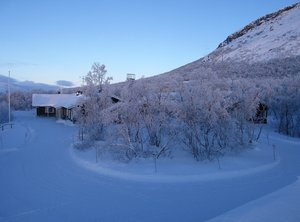Kilpisjärvi Biological Station

Address
Kilpisjärvi Biological StationKäsivarrentie 14622
F1-99490 Kilpisjärvi
Station manager
Hannu AuttoContact Station
Phone: +358294120300https://www2.helsinki.fi/en/research-stations/kilpisjarvi-biological-station
Station Features
Opening year: 1964 Status: OpenFacilities
Station name and owner
The Kilpisjärvi Biological Station belongs to the University of Helsinki (Faculty of Biological and Environmental Sciences).
Location
The station is situated in the community of Enontekiö in the northwestern part of Finnish Lapland (69°03’ N, 20°50’ E) on the shore of Lake Kilpisjärvi at 475 m a.s.l. close to Sweden and Norway.
Climate data
Grey colours are WMO Climate Normals including maximum and minimum values. Blue colours are individual years.
Climate data for the stations where extracted via Copernicus Climate Data Store, from the global gridded reanalysis product:
ERA5 monthly averaged data on single levels from 1940 to present.
Description and source code: Roemer J.K. 2023. https://doi.org/10.5281/zenodo.10214922
Data Source: Hersbach et al. 2023. Copernicus Climate Change Service (C3S) Climate Data Store (CDS), https://doi.org/10.24381/cds.f17050d7
Biodiversity and natural environment
The landscape around the station is dominated by “Fjells” (mountains or high plateaus above the tree line) extending into the Scandinavian mountain range, e.g. Fjell Saana (1029 m a.s.l.) and Pikku-Malla (738 m a.s.l.). The research station lies c.100 km north of continuous coniferous forest and belongs to the sub-alpine birch forest zone, with mountain birch being the dominant plant species. The area is dominated by a wide range of ecosystems from mountain birch forest at low altitude (480-600 m) to alpine tundra (above 600 m). The majority of the area is a mosaic of treeless alpine heath and ponds. Due to the calcareous bedrock, the Kilpisjärvi area is a hotspot for many calcophilic and endangered mountain plant species. As a consequence, the lepidofauna in this area is exceptionally diverse (more than 340 species are recorded). The Kilpisjärvi region is also famous for rich avifauna of northern and mountainous species, like the bluethroat (Luscinia svecica), the ring ouzel (Turdus torquatus), and the dotterel (Charadrius morinellus). The Norwegian lemming (Lemmus lemmus) is the most characteristic mammal species.
History and facilities
The station with its four buildings was officially opened in 1964. In the main building, there are two lecture halls (with space for either 30 or 60 people, one of which also serves as dining room), computer room, library, kitchen, and laboratory facilities. Laboratories have a supply of electricity, gas, compressed air, and running water, and are equipped with refrigerator, ovens, freezers, spectrophotometer, micro- and macro-scales, microscopes, centrifuge, pH- and conductivity meters, thermometers, etc. Also a wide variety of field equipment is available, together with boats and snowmobiles. Ars Bioarctica bioart laboratory is affiliated to the station (http://bioartsociety.fi/ars-bioarctica). The library contains a collection of zoological, botanical, geographical, and statistical handbooks. Telephone, fax, copy machines, and computers with access to internet are provided. WLAN is accessible in the station area. The accommodation capacity is about 50 persons, and meals are served daily at the station. There is a permanent staff of eight persons.
General research and databases
Widely respected long-term follow-up studies form the core of the scientific activities at the station. The longest observation series (>50 years) are on fluctuations of small rodent densities. Population dynamics of passerines have been monitored since 1957. Long-term research projects also include the periodicity in quality and quantity of vegetation in the mountain region. Effects of environmental changes have been monitored for instance in the International Tundra Experiment (ITEX). The specific long-term studies are backed by more extensive studies on climate, vegetation, soils, rodents, birds, predators, etc. Limnology is a rising branch of research. Lately research activities have extended from animal and botanical ecology to hydrobiological and paleolimnological research. Projects such as MOLAR, CHILL, LAPBIAT, and SCANNET have been carried out in Kilpisjärvi in addition to regular studies on geography and geophysics. The Kilpisjärvi Biological Station is the Finnish representative in the ITEX-project. Since 2007 the station has been part of the Finnish Northern LTSER program, in which data from long-term follow-up studies will be organised and digitized in an EU-funded LTER-project. A bibliography of publications arising from research at the station is available. There is an also an extensive collection of climate records and biological data on plants and animals available from the station. The station publishes its own newsletter “Kilpisjärvi Notes”.
Station Monitoring
Human dimension
Reindeer husbandry, tourism, and research dominate in the area. Recent construction and development plans in the village may pose a threat for the future of some of the long-term studies.
Access
The station is easily accessible by air or bus (via Rovaniemi). Within a two hours car journey there are two airports, Enontekiö; in Finland and Tromsø; in Norway. Also Kiruna airport in Sweden is relatively close to the station.


